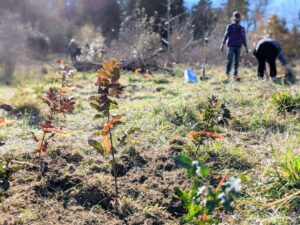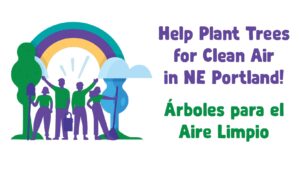Category: Green Space
Friends of Trees, Friends of Bees
How we can plant to promote native pollinators
Next time you see a bee buzzing around your garden, take a closer look. It’s cute, right? And on top of that, it’s performing a very important ecological process—pollination!
Last month we hosted two pollinator workshops in Washington county during National Pollinator Week, thanks to funding from the Tualatin Soil and Water Conservation District. Folks gathered at the PCC Rock Creek Learning Garden and at Tualatin River National Wildlife Refuge to take a tour of pollinator-friendly plants, learn what makes for good pollinator habitat, and to spot some native bees along the way. Friends of Trees staff shared their knowledge on the topic and led activities to guide people in designing their own pollinator gardens.
What is a pollinator? Pollinators are animals (mostly insects) that move pollen from a flower’s male part to its female part in their search for sustenance, making that plant’s reproduction possible. This process makes pollinators a really key part of both agricultural and ecological systems. 35% of our food sources and 75% of flowering plants depend on pollinators.
“Unfortunately, we’re seeing a massive, unprecedented decline in native bees and other pollinators,” says Thomas Meinzen, a Neighborhood Trees Specialist at Friend of Trees who studied pollinator ecology and conservation in graduate school. In some countries, studies have shown more than 75% decline in insect biomass in 30 years. Because pollinators are relatively understudied, the impacts and ramifications of this decline are not fully understood.
“There are a lot of contributing factors, including pesticide and herbicide use, grazing practices, agricultural monocultures, habitat loss and climate change,” Thomas says. “It’s scary, but there are still things we can do.”

IN OUR OWN BACKYARDS
We can create habitat in our own backyards and parks. Luckily, we don’t need entire wilderness areas for pollinators to live in. You can help by planting a variety of flowering plants to provide food for pollinators from spring all the way into fall.
“Trees are particularly helpful here because they flower earlier in the year than most smaller flowering plants, providing food for early-season pollinators like bumble bees,” Thomas says. “Trees like California buckeye, cascara, hawthorns, willows, and fruit trees are all great options for native pollinators.”
It’s also best to cultivate a diversity of flower shapes, colors, and types to attract a diverse array of pollinators. Bees, butterflies, and flies are all pollinating insects looking for different types of food.
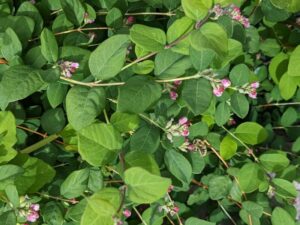
NATIVE PLANTS FOR NATIVE POLLINATORS
It makes sense that native pollinators are attracted to native plants. Our Green Space program enhances natural areas by planting many thousands of native shrubs and plants each planting season, improving air and water quality and creating habitat for wildlife, including pollinators.
“A lot of our Green Space plantings are designed to improve water quality in particular,” says Kaitie, a Green Space specialist. “But these plants are great for pollinators, which is more than just an added bonus.”
Plants like red-flowering currant and Oregon grape are common at our Green Space plantings and favorites for pollinators. Our Green Space plantings also leave open ground where bees can nest.
Many people express concern for honeybees, not realizing that honeybees come from Europe and can potentially outcompete native bee species. There are over 4,000 native bee species in the United States and over 650 in Oregon.
“There’s a lot of growing interest in pollinators,” Thomas says. “It was exciting to see that at our pollinator workshops with great turnout, in-depth conversations, and the chance to send folks home with pollinator plants.”
The best things we can do to protect and promote native pollinators are to avoid using pesticides and herbicides on our properties, plant flowers and native plants, and leave things a little messy so that pollinators can make themselves at home in our gardens.
Wilkes Creek – Connecting a Community
New funding will develop the Wilkes Creek Headwaters into an accessible natural area
For three planting seasons, Friends of Trees volunteers have been enhancing the natural area at the Wilkes Creek Headwaters in outer East Portland. The 20.7-acre hybrid park is nestled in the neighborhood, and provides opportunities for local residents to connect with nature. The site was jointly purchased by Portland Parks & Recreation, the Bureau of Environmental Services, and Metro in 2011, and it will be preserved and enhanced as a public space for generations to come.
The natural area is particularly special because it is home to the headwaters of Wilkes Creek, which flows into the Columbia Slough. Just past the planting site, you can see the natural springs where water comes to the surface and turns into a stream.
“The headwaters can be seen bubbling up from the earth near the midway point of the property,” says Maija Spencer, Senior Community Engagement Coordinator for Portland Parks & Recreation. “Forty bird species, coyotes, and the Stumptown scud—a freshwater crustacean found only in the Portland area—call the property home.”
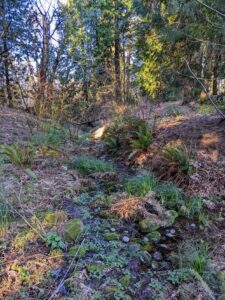
“Wilkes Creek is one of the only remaining free-flowing above-ground streams that makes its way into the Columbia Slough,” says Yoko Silk, a Stewardship Coordinator with PP&R. “There used to be hundreds, now there’s only a handful. So it’s really special for being that source of cold, clean water into the slough. And it provides a really important habitat to all sorts of critters.”
Friends of Trees volunteers have planted native plants throughout the central part of the park as part of the Greening Wilkes Initiative. There’s a wildflower meadow, where they’ve put in thousands of camas, checker mallow, lupine, yarrow, goldenrod, and many more. On the hillside, below an old hazelnut orchard, they have planted shrubs and small-form trees like serviceberry, Oregon grape, snowberry, and oceanspray.
“We want visitors to feel transported,” says Green Space Senior Specialist Harrison Layer. “We’re preserving this natural space as a beacon for birds flying overhead, and wildlife on the ground.”
Wilkes Creek Headwaters has received 8 million dollars in funding for its preservation and development through Portland Parks and Recreation. This park is considered a hybrid space because it’s being enhanced as a natural area at the same time it’s being developed into a usable park with benches, trails, and educational signage. In addition to providing the community with more access to green spaces, developing trails and signage will help protect the natural area that the community has worked so hard to develop.
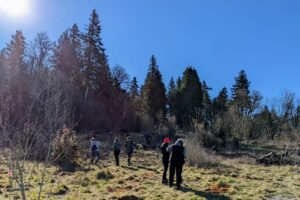
“Portland Parks & Recreation will collaborate with partners and community members to create a plan for developing the park, with a focus on including the voices of Native and Indigenous communities and communities of color,” Maija says. “The goal is to enhance the park’s natural features, while also providing more recreational opportunities and access to nature for East Portland residents.”
“This is an important park because of its location in East Portland, an area that has less park space and opportunities to connect with nature,” Harrison says. “It also shows the connectivity that a creek can bring to a community. It starts at the park, moves through neighborhoods and industrial space, and eventually flows into the slough. Protecting this area will help protect the Columbia Slough as a whole.”
The Greening Wilkes Initiative incorporates a layered approach to community engagement. Community organizations have joined together in the collaborative effort to enhance and diversify green spaces throughout the neighborhood around Wilkes City Park and Wilkes Creek Headwaters in outer East Portland. Friends of Trees, Portland Audubon, Verde, Columbia Slough Watershed Council, and Portland Parks & Recreation each provide their unique and complementary approaches to community engagement around important natural resources in the Wilkes community.
“I’ve had community members tell me that they didn’t even realize that this natural spring was here,” says Harrison Layer, our Green Space Specialist who leads Wilkes Creek plantings. “It’s really special to share it with them.”
You are invited to join in shaping the future of this special place by joining the email list and applying for the project advisory committee. More info can be found here.
Clean Air Canopy
Trees for Clean Air in NE Portland
If you live in Sumner, Cully, Parkrose, Argay, or Wilkes, register here to get a free tree!
Of all the benefits that trees provide, clean air is one that entire communities benefit from. When the Owens-Brockway glass facility was found to be excessively polluting in the vicinity of several Northeast Portland communities and the Columbia Slough Watershed, the Oregon Department of Environmental Quality fined the facility and granted funds to Friends of Trees and our partners to lead community tree plantings in the area.
Friends of Trees, in partnership with community members and organizations, will coordinate the planting of 5,000 native plants and trees over the course of the Clean Air Canopy project.
Of these, about 800 trees will be located along neighborhood streets and private properties in the Sumner, Cully, Parkrose, Argay, and Wilkes neighborhoods. 4,200 more native plants and trees will be planted in natural areas located across these neighborhoods and along the Columbia Slough watershed.
This project would not be possible without our partners: Verde, the Cully Air Action Team (CAAT), and the Cully Association of Neighbors. Verde and CAAT’s advocacy work held this polluter accountable and led to this project’s creation. These partners have been instrumental to our outreach efforts.
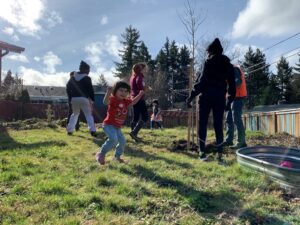
“This project really represents the breadth of what we do at Friends of Trees,” says Green Space Program Manager Michelle Yasutake. “Working in both neighborhoods and natural areas, connecting with community members, and providing a tangible benefit in the form of cleaner air.”
These new trees and native plants will improve air quality and the quality of life for residents of these NE Portland neighborhoods. Leaves from the trees planted in this project will not only intercept and store particulate matter from the air, they will provide shade and cooling benefits, lessen urban heat island effects, and improve habitat and stormwater management.

Friends of Trees is already working with community members to identify planting locations. Planting and caring for the trees together gives us a chance to talk with the community about the positive impacts of clean air, clean water, and healthy urban tree canopy in neighborhoods and nearby industrialized areas.
“We’re really excited for this opportunity to form connections with residents, and to work alongside them to understand their needs and bring trees to their community in a way that works best for them,” says Aliesje King, the Neighborhood Trees Program Manager at Friends of Trees.
If you live in Sumner, Cully, Parkrose, Argay, or Wilkes, reach out to us to get a free tree! Register here, or email us at [email protected] with any questions.
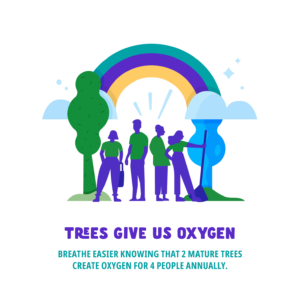
Friends of Trees to the Rescue!
Rescuing native plants along the new Salmonberry Trail project
Usually Friends of Trees volunteers are tasked with planting trees, but last weekend in Banks, they got to rescue them! Volunteers worked on a stretch of railway, part of a route once home to the Pacific Railway and Navigation rail line, that will become the Salmonberry Trail in coming years.
Because the railway isn’t used anymore, native trees have sprouted among the tracks. Working along the scenic West Fork Dairy Creek, volunteers set about rescuing them by safely digging up knee-high bigleaf maple and Douglas-fir saplings, soaking them in water and storing them in bare-root bags. They used special de-rooter tools for the most obstinate trees.
“We’ve been out here for a couple years now, leading work parties,” says John Vogler of the Salmonberry Foundation to volunteers. “Next year, we will clear this whole section with big machines, so any trees that we can salvage is great. It’s a big task, and you’re part of the very beginning of this 86 mile trail to the coast.”
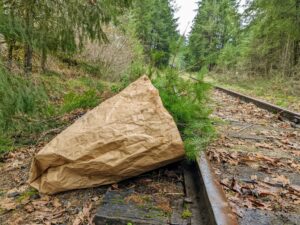
This rails-to-trails project will create a new 86-mile mixed-use path for walkers, runners and cyclists. The Salmonberry Trail will also connect to the existing Banks-Vernonia Trail to create a loop.
This event came to us thanks to our longtime partner Clean Water Services, whose Tree for All campaign has planted more than 14 million trees and shrubs in Washington County. They proposed this tree rescue event as a fun way to engage folks in the Banks community with our work. Rescuing plants isn’t typical for Friends of Trees, but the nature and scale of this specific project made it a good fit for volunteers.
With their hard work, volunteers rescued 375 bigleaf maples and 100 Douglas-firs from the tracks. They were safely stored by Clean Water Services in their cooler until they were planted elsewhere in the Tualatin River Watershed. The Doug-firs went to a Tualatin Soil & Water Conservation District project along East Fork Dairy Creek. The maples were planted at the Penstemon Natural Area on the Tualatin River near Forest Grove, and at Rivers Bend Natural Area on the Tualatin River near the Tualatin River National Wildlife Refuge.
Volunteers also cleared a quarter mile of future trail of invasive Scotch broom and Himalayan blackberry and 100 pounds of trash.
Volunteers were excited to rescue about 100 more trees to plant at their own homes, including cherries and hazelnuts. “It was fun to come to a different event like this,” said Hannah, a volunteer. “And so great to take a native tree home to plant!”
Thanks to Clean Water Services, The Salmonberry Foundation, and Friends of Stub Stewart State Park & Banks-Vernonia Rails to Trails for partnering with us on this project.
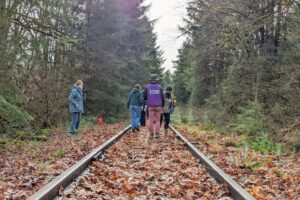
Tree walks & tree talks for you
It’s the 50th anniversary of Earth Day this year. Friends of Trees was planning to celebrate in our usual fashion: Planting trees. Together. But, like everyone, our plans changed.
We would, of course, prefer to be outside with you. But since we can’t we have some really special virtual tree treats for you.
Since trees and nature can be so comforting, the Friends of Trees staff contributed to Earth Day with some homemade tree talk videos; we’re hoping these will tide you over until we can plant trees with you again. Below is a selection of our work, you can find the entire playlist here (we’ll be adding more, so check back!).


